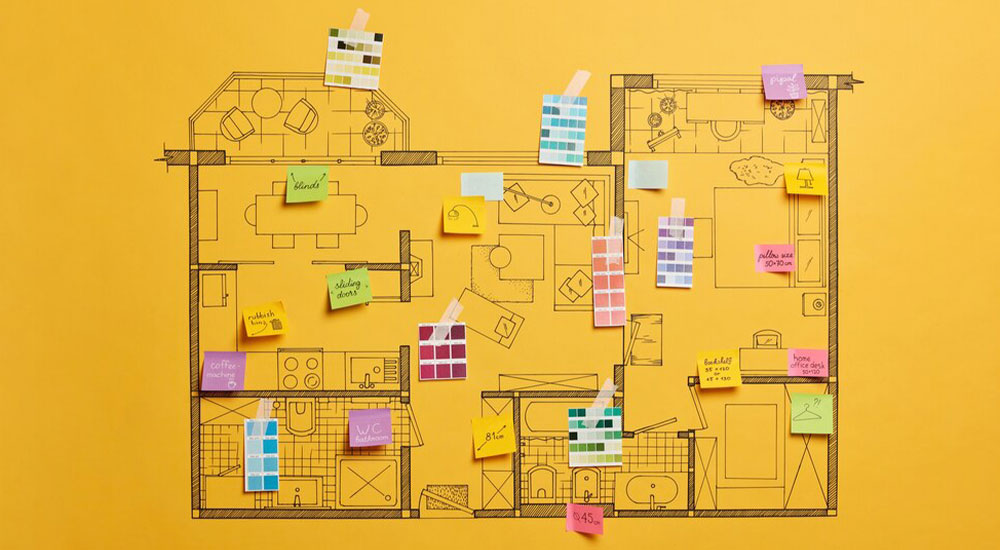Quick Links
Get in Touch
- (042) 111 300 600
- +92 3041111739
- info@apexgroup.pk
- 1st Floor, IEP Building Liberty Round About Gulberg |||, Lahore
Join us
Get updates on special events

The open-concept floor plan is a popular choice in new construction since the modern home interiors provide an airy space for entertaining, collaboration and creativity. However, some people prefer the privacy of a traditional floor plan instead modern floor plan. In this blog, we’ll discuss the benefits and drawbacks of each home layout so you can decide which one meets your needs best.
The open-plan living differs from traditional layouts by eliminating walls and barriers, giving the home an open, ample and airy feel. Whereas, the traditional living exhibits clearly defined rooms separated by walls and doors that provide full privacy.
Although open concepts have been the modern choice over the last decade, many experts agree that traditional floor plans are gaining popularity as people spend more time at home. Thus, to choose the best layout for your home, it’s important to consider both options and choose the one that will complement your lifestyle.
Open-concept floor plans are at their peak. This spacious design makes small homes look bigger, and without walls, you’ve got plenty of options to create different spaces by arranging furniture just the way you like it. Such as you can set a modern design sofa or a wooden couch design. As furniture for open-plan spaces making hype in recent twice decades. This can be done in single-story home plans that work as luxury apartments. This style also integrates into modern living room layouts.
Furthermore, without any barrier, sunlight can easily flow through your home, making it bright and airy. This floor plan design is also a great choice for people with large families or those who want a place for entertainment.

Open kitchen plan is gaining hype in open floor plans. As, it is suitable for females in several ways. Such as, they can be efficiently multitasking like engaging with guests while cooking in the open kitchen. So, instead of being stuck in the kitchen, you can chat with friends or loved ones in the living room while preparing dinner and drinks. Additionally, open-plan kitchen is best for mothers who can’t leave their child alone but need to cook something.
Open floor plans have become a hallmark of modern home design, and it’s easy to understand why. Here are some of the standout advantages:
A sense of space is one of the hallmarks of an open-concept floor plan. Your rooms feel larger and there’s more of a sense of natural, open movement in the house.
You’re also able to naturally brighten your space and make it more lively throughout the day with sunlight, illuminating the space and creating a brighter, more inviting environment.
If you’re someone who loves hosting gatherings, open floor plans are a great option. Your guests can move easily throughout your home, fostering a more social atmosphere. Even if you’re taking care of things for party guests, you’re always nearby to socialize.
You also have the freedom to move things around in your space whenever you need. Adding members to the family? Looking to freshen up where furniture sits in your space? Not a problem with an open floor layout.
There are also some drawbacks of an open-concept design, as it’s not the best choice for every home. An open concept makes it harder to find privacy since there aren’t a lot of walls and separations. Moreover, you’ll have to find the right decor that achieves a cohesive look throughout the home. An open concept without barriers allows sounds and smells to travel more easily throughout the home. It is often less efficient to heat in the winter.
However, open floor plans aren’t without their challenges:
Whether you need to focus on work or take a moment for yourself, the open space can make it challenging to find a secluded spot. Open space means much more active foot traffic.
Sound travels easily in open spaces. Do you have active kids, or dogs that love to bark? That sound is going to carry much further more easily.
To keep the design of your home consistent, you’ll likely need a singular approach to design that flows throughout your home.
You might be looking at higher heating and cooling bills, thanks to having larger open spaces.
Love cooking? The smell is going to carry throughout your home. This might not be agreeable to all of your residents.

The closed concept or traditional living is typically seen in older homes, but it’s gaining popularity as people spend more time at home. With barriers and walls in abode, the traditional floor plan allows for privacy that you can’t get from an open-concept design. Sound doesn’t travel as much, making it easier to find peace and quiet when you need to work or study, and keeping each room tidy is much easier.
Since each room is a separate space, you can decorate without worrying about an overall cohesive look as you would with an open-concept design. The walls and doors also make heating and cooling your home much more energy-efficient.
Traditional floor plans, often referred to as closed floor plans, have been a staple in home design for years. Here’s why many still gravitate towards them:
One of the standout features of traditional floor plans is the enhanced privacy they offer. Easily retreat to a quiet space to get your work done or enjoy a hobby for some alone time.
Each room in a traditional floor plan has a clear, defined purpose. These defined spaces can bring a sense of order and structure to daily life, from sharing meals with family in the dining room to having a family movie night in the living room.
With separate rooms, you can experiment with a range of different designs. Love a rustic flair? There’s space in your kitchen! Love mid-century modern? Highlight that in your living room!
You can choose to condition only the rooms you’re using, potentially saving on energy costs.
Traditional floor plans have a few drawbacks that can make them less desirable for certain people. Walls and doors make it harder for sunlight to illuminate your home, and the overall layout may look less spacious. This layout may also be less accessible for people with wheelchairs or other mobility aids.
However, traditional floor plans come with their set of challenges:
Walls and doors can sometimes break up the flow of a party or other opportunities to socialize.
You’re going to have less opportunity to use natural light, and that means needing to get creative with intimate lighting.
Traditional floor plans can sometimes make spaces feel smaller or more confined, especially if you live in a smaller home.
If you’re craving a big change in your home, moving furniture between rooms is going to be more of a challenge. Think about measuring a couch to make sure it can fit through your door.
There is no easy answer to this question. In a nutshell, it all depends on what you’re looking for. If you’re looking for an open, airy feel with a space to entertain, you’re going to enjoy an open floor plan. You can also easily rearrange furniture and change up what the space does as the needs of your family change.
If you prefer privacy and a more easily compartmentalised living space, traditional floor plans are good to go. You can cultivate different aesthetics throughout your home, and keep your place more energy efficient. Most rooms can also double as a quiet place to work, reflect, or just enjoy a quiet hobby.

Get updates on special events
Secure your success with our lucrative investment opportunities and unmatched expertise.
Get in touch with our professional and efficient team at Apex Group and elevate your lifestyle.